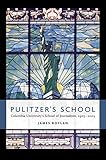Pulitzer's School : Columbia University's School of Journalism, 1903-2003 / James Boylan.
Material type: TextPublisher: New York, NY : Columbia University Press, [2003]Copyright date: ©2003Description: 1 online resource (337 p.) : 32 PhotosContent type:
TextPublisher: New York, NY : Columbia University Press, [2003]Copyright date: ©2003Description: 1 online resource (337 p.) : 32 PhotosContent type: - 9780231130905
- 9780231500173
- 070.4/071/17471 070.407117471
- PN4791.C7 B69 2003
- online - DeGruyter
- Issued also in print.
| Item type | Current library | Call number | URL | Status | Notes | Barcode | |
|---|---|---|---|---|---|---|---|
 eBook
eBook
|
Biblioteca "Angelicum" Pont. Univ. S.Tommaso d'Aquino Nuvola online | online - DeGruyter (Browse shelf(Opens below)) | Online access | Not for loan (Accesso limitato) | Accesso per gli utenti autorizzati / Access for authorized users | (dgr)9780231500173 |
Browsing Biblioteca "Angelicum" Pont. Univ. S.Tommaso d'Aquino shelves, Shelving location: Nuvola online Close shelf browser (Hides shelf browser)

|

|

|

|

|

|

|
||
| online - DeGruyter Wild Kids : Two Novels About Growing Up / | online - DeGruyter Shakespeare on Love and Lust / | online - DeGruyter Serendipities : Language and Lunacy / | online - DeGruyter Pulitzer's School : Columbia University's School of Journalism, 1903-2003 / | online - DeGruyter Willa Cather : Queering America / | online - DeGruyter Marked Men : White Masculinity in Crisis / | online - DeGruyter No Return Address : A Memoir of Displacement / |
Frontmatter -- CONTENTS -- Preface -- Introduction -- 1. "I Have Selected Columbia" -- 2. Schools for Journalists? -- 3. "Dealing with a Wild Man" -- 4. "A Posthumous Affair" -- 5. "We Will Start Right Away" -- 6. A Building Called "Journalism" -- 7. "What Journalism Will Do to Columbia" -- 8. "If Sedition Is to Be Excluded" -- 9. Red Apple and Maraschino Cherry -- 10. The First Dean -- 11. "Ackerman Hails Stand of Press" -- 12. The Graduate School -- 13. Speaking to Cabots -- 14. "My Dear Dean" -- 15. Outpost in Chungking -- 16. "Sweat and Tears" -- 17. Postwar Ventures -- 18. The Dean and the Prizes -- 19. "Training Ground" -- 20. "The Pulitzer Mandate" -- 21. From Dropout to Dean -- 22. Short-Changed -- 23. "Why a Review?" -- 24. Era of Expansion -- 25. Edging Toward the Abyss -- 26. Fallout -- 27. Desperately Seeking a Dean -- 28. "Welcome to the Joint" -- 29. Hohenberg and the Prizes -- 30. Meeting Fatigue -- 31. "It Appears You Have a New Dean" -- 32. CJR-From New Management to Old -- 33. "Sour Apples" -- 34. Showdown -- 35. To the Exits -- 36. The Conglomerate -- 37. "Deans' Row" -- 38. Trying to Stretch the Year -- 39. "Clearly Insufficient" -- 40. Has the Pulitzer Idea Survived? -- On Sources -- Notes -- Index
restricted access online access with authorization star
http://purl.org/coar/access_right/c_16ec
Marking the centennial of the founding of Columbia University's school of journalism, this candid history of the school's evolution is set against the backdrop of the ongoing debate over whether journalism can-or should-be taught in America's universities.Originally known as "the Pulitzer School" in honor of its chief benefactor, the newspaper magnate Joseph Pulitzer, Columbia's school of journalism has long been a significant and highly visible presence in the journalism community. But at the turn of the twentieth century, when the school was originally conceived, journalism was taught either during an apprenticeship at a newspaper office or as a vocational elective at a few state universities-no Ivy League institution had yet dared to teach a common "trade" such as journalism. It was Pulitzer's vision, and Columbia's decision to embrace and cultivate his novel idea, that would eventually help legitimize and transform the profession. Yet despite its obvious influence and prestige, the school has experienced a turbulent, even contentious history. Critics have assailed the school for being disengaged from the real world of working journalists, for being a holding tank for the mediocre and a citadel of the establishment, while supporters-with equal passion-have hailed it for upholding journalism's gold standard and for nurturing many of the profession's most successful practitioners.The debate over the school's merits and shortcomings has been strong, and at times vehement, even into the twenty-first century. In 2002, the old argument was reopened and the school found itself publicly scrutinized once again. Had it lived up to Pulitzer's original vision of a practical, uncompromising, and multifaceted education for journalists? Was its education still relevant to the needs of contemporary journalists? Yet after all the ideological arguments, and with its future still potentially in doubt, the school has remained a magnet for the ambitious and talented, an institution that provides intensive training in the skills and folkways of journalism. Granted unprecedented access to archival records, James Boylan has written the definitive account of the struggles and enduring legacy of America's premiere school of journalism.
Issued also in print.
Mode of access: Internet via World Wide Web.
In English.
Description based on online resource; title from PDF title page (publisher's Web site, viewed 02. Mrz 2022)


